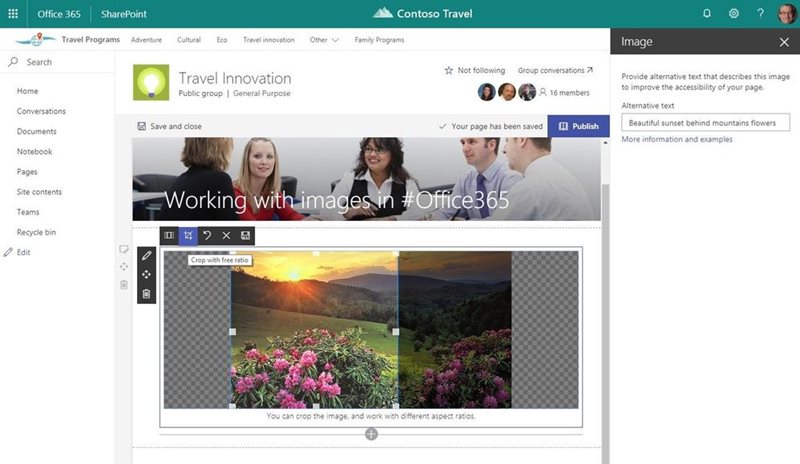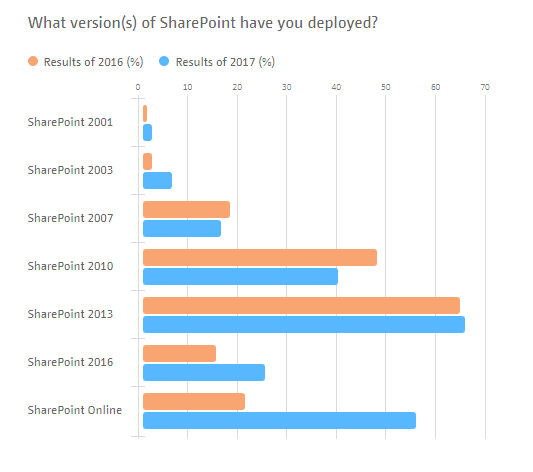Mark Kashman on Microsoft's Inclusion in Gartner MQ for DXPs
Last month, Gartner published its first Magic Quadrant for Digital Experience Platforms (DXPs)  where the Stamford, Conn.-based research firm evaluated 21 vendors based on their DXP offerings. Microsoft has been classified as one of the “Challengers” in the Gartner report. An arsenal of Microsoft products, including Azure, Dynamics Business Solutions and Office 365, have been included in the evaluation process as they all address DXP requirements. However, Gartner specifically draws attention to SharePoint Online as it is the focus of most DXP efforts by Microsoft customers.
where the Stamford, Conn.-based research firm evaluated 21 vendors based on their DXP offerings. Microsoft has been classified as one of the “Challengers” in the Gartner report. An arsenal of Microsoft products, including Azure, Dynamics Business Solutions and Office 365, have been included in the evaluation process as they all address DXP requirements. However, Gartner specifically draws attention to SharePoint Online as it is the focus of most DXP efforts by Microsoft customers.
Following the release of the Gartner report, we reached out to Mark Kashman, senior product marketing manager for the SharePoint team, to go more in-depth on their inclusion as well as the future plans for their product development.
What do you feel Microsoft has done to contribute to their recognition in the MQ for DXPs and how do you intend on keeping up that momentum?
Kashman: “Gartner’s inaugural shift from a portals MQ to a Digital Experience Platform (DXP)  MQ gave Microsoft the ability to showcase the breadth and depth of our offerings across the broader DXP space. Microsoft placed positively due to its strengths in the productivity criteria, through leading use of artificial intelligence (AI) and bringing the power of solutions to all with PowerApps and Flow.”
MQ gave Microsoft the ability to showcase the breadth and depth of our offerings across the broader DXP space. Microsoft placed positively due to its strengths in the productivity criteria, through leading use of artificial intelligence (AI) and bringing the power of solutions to all with PowerApps and Flow.”
“We have an excellent partner ecosystem that helps enhance, build and deploy DXPs solutions across the industry. Gartner recognizes the value of clean, dynamic user experiences, the manageability, and governance for IT, and the option of expression for developers to embody the requirements of the business into scalable, resilient solutions. Across Office 365, SharePoint, Azure and Dynamics, our products and services provide quick time-to-market and customization options across the landscape of intranet, extranet, and internet zones.”
While Gartner’s reference customers continued to report high satisfaction levels with Microsoft’s deep and readily deployable capability for B2E DXP scenarios, Gartner also cited:“Microsoft offers less fully developed and competitive offerings for B2C commerce and customer service.” Are there any ongoing projects to address this growth opportunity?
Kashman: “Via Microsoft 365, Microsoft promotes its cloud platform for public-facing solutions, spanning both Azure and Dynamics (see Azure eCommerce solutions). Microsoft will further promote Azure + Dynamics for B2C commerce and customer service use cases. With the overall pace of cloud and desktop from Windows 7 to Windows 10 & from on-premises into the Microsoft cloud – along with hybrid – we will help and guide upgrades, migrations, usage, and adoption -- with new offerings from FastTrack, customer success managers (CSM), and our partner service integrators, we plan to keep our customers informed and engaged.”
In the DXP market, what trends do you see on the horizon or where do you think we will see the most innovation in the coming months?
Kashman: “AI, personalization, and monetization, will drive the next round of DXP innovation. And this will be across all user surfaces from peer-to-peer, B2B, B2C and machine-to-machine – across internal, external and public zones. Microsoft is investing heavily in R&D to innovate and grow. And, beyond the technology, we focus on training and feedback loops with our ecosystem of partner and customers. As long-time trusted advisors, we listen, lead and delight with new offerings and patterns and practices so our customers and partners see value from their existing investments, and know where and how to move forward.”
Microsoft Rolling Out Some Share Point Online Previews
SharePoint 2016 was the first iteration rolled out since Microsoft moved to its cloud-first, mobile-first innovation strategy. The new roadmap made the platform more relevant and useful for modern web users. SharePoint is now a comprehensive platform that can meet many enterprise challenges and needs.
Since that release, Microsoft has been making enhancements to SharePoint to make the platform an eventual game-changer for customers who either have been using SharePoint for some time, have not really understood how to maximize the value of SharePoint or who are still not quite sure how to bridge SharePoint from on-premises to cloud.
Moving forward, with the release of SharePoint 2019, Microsoft provides new AI-first capabilities to help enterprises with hybrid environments get the most out of the MS Graph, machine-learning, and analytics.
Last month, Microsoft rolled out a few new capabilities in preview form for Office 365 subscribers. One of the releases was the ability to create and use custom site designs. This ability is rolling out to Targeted Release Office 365 customers, according to Microsoft. While they apply to both team sites and communication sites, with custom site designs and custom site themes, users will be able to best align the preferred look, feel and structure. Microsoft has also been rolling out support for SharePoint administrators to create and upload custom site scripts and site designs.
Another long-desired capability being rolled out is SharePoint pages and image editing updates. If you have a series of pages you’ve created with a similar layout and design, you can now go to an existing page and use it as a quick start to create a whole new page – but with a head start, says Microsoft. From an existing page, click New and then select Start with a copy of this page. The service will create the new page, and you simply jump into updating with new text, images, and content updates, with layout, design and common text already in place. Also, with its new and more robust text editing capabilities, you have greater control over how your text appears. From the inline simple command bar, you can adjust size, bold, underline and spacing. You can learn more about the new text editing capabilities, here. When it comes to the image enhancements, the most striking one is the ability to pull in an image from online (powered by Bing) that are tagged as Creative Common licensed to enhance your pages and news. Once your images are on the page, you can edit them in line with simple gestures like adjusting the ratio and cropping.

Other SharePoint Updates in Office 365
The other updates that are begging to be rolled out and are not yet available to all applicable customers are:
-
Customer forms with PowerApps
-
Column formatter
-
Forms Web Part
-
File Move in SharePoint and OneDrive
-
Bulk metadata editing
-
Improved search experience in SharePoint
Among the new updates listed above, the ability to move files in Office 365 with full fidelity protections for metadata and version management. With this release, there are a few important content management use cases that have been unlocked for users.
-
Migration: Now, if you discover a file in the marketing site that belongs with sales files, for example, you can move that document without manual processes that can truncate metadata.
-
Sharing: Now, you can move the file to your team site, without losing version history unlike other methods of moving the file into a shared location.
-
Publishing: You can move the file to a communication site from a team site if you want to publish that document to a broader audience across the organization.
-
Modernizing your information architecture: When you need to set up a new team site while bringing related docs from the previous projects, now, you can pick folders from an older team site and move them to a newer one.
-
Multigeo: You can also move legacy content to new sites in your new geographies.
SharePoint Online and SharePoint 2016 Have Gained Significant Ground
Three months after SharePoint 2016 was being introduced, we also covered an AIIM study titled ‘The Impact of SharePoint – 2016’. According to the key findings, only 43% of respondents were somewhat aware of what SharePoint 2016 offers and 29% indicated they have no awareness at all. On the bright side, 58% had said SharePoint is popular for project and team site use as a collaboration tool back then.
A recent study has lately been released by Sharegate, Hyperfish and Nintex, citing that SharePoint 2016 has seen a 67% increase in deployment, while SharePoint Online deployments rose by 167%. From which version are users fluxing to SharePoint Online? Mostly from SharePoint 2007, followed by SharePoint 2010. On this note, another data point from the study tells us hybrid environments (a mix of SharePoint Online and on-premises SharePoint deployments) decreased by 7 percentage points to 34% and on-premises-only environments dropped by 2 percentage points to 35 percent in 2017.

The number of organizations starting to move to Office 365 completely increased by 35%, however they still have security and cost related concerns that need to be addressed by the vendor. Another interesting finding is that Office 365 Apps, OneDrive for Business, and Delve appear to receive the most adoption gains compared with 2016. To view the other key findings from the Global SharePoint Survey 2017, you can download the PDF version, here.
My POV
Since Microsoft announced a new cloud-first, mobile-first vision and roadmap for its SharePoint solution in 2016, the vendor has continuously been innovating all the components of its digital experience platform. Although some users have been struggling with staying on top of new features, Microsoft is going beyond the catching-up game by democratizing the creation of experiences and workflows with the latest technology. That being said, many moving parts are still in progress to come together as a whole. When all those things come together, though, it will very hard for its rivals to match Microsoft’s broad and growing range of capabilities.

Venus Tamturk
Venus is the Media Reporter for CMS-Connected, with one of her tasks to write thorough articles by creating the most up-to-date and engaging content using B2B digital marketing. She enjoys increasing brand equity and conversion through the strategic use of social media channels and integrated media marketing plans.